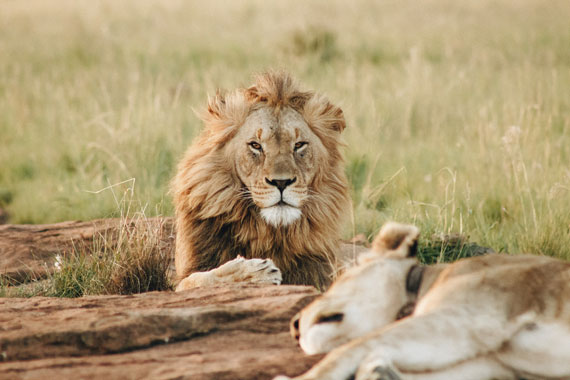Wildlife photography can be, well, wild — especially if you’re photographing the king of the jungle in its domain! Lions are ferocious predators, known to hunt in pride’s, taking down small to large prey like wildebeest and buck. While a photo of a male lion and his resplendent mane can certainly be impressive, lionesses, their cubs, and antics also make stunning subjects. In this YouTube video, Janine Krayer of Pangolin Photo Safaris offers her advice on shooting lions in the wild.
Be Ready for The Action
Lions can move very fast, meaning you need to have your camera set up and settings sorted. Yes, they do sleep most of the day (around 16-18 hrs). However, when awake, lions tend to be quite active, interacting with each other, pouncing, and butting heads. As such, Janine says it’s a good idea to keep your shutter speed fast — a minimum of around 1/2000 of a second. Additionally, opt for a smaller aperture for group lion photos (around F8-F10).
It can be difficult to shoot cubs as lionesses keep them safe and out of view until a few weeks of age. For these subjects, Janine says it’s better to use a large-aperture prime lens of F2.8 to F4.
Lions are most active in the early morning and dusk hours, making low-light conditions a problem. To remedy this, Janine suggests an ISO of 6400 while adjusting your shutter speed to 1/6000 and aperture to F5.6. Alternatively, a slower shutter speed of 1/800 with an aperture of F5.6 — or F8 and 1/650 — if the lion stationery. And remember, even grainy high-ISO images look great in black and white.
Keep Safe
Lions can run up to 80kmph, are powerful, and have rather ferocious jaws and claws. As such, you need to be careful when shooting them. A pride can consist of up to 40 individual lions, but even a handful of lions approaching can scare the majority of sightseers. It’s a good idea to stay in your vehicle and follow your guide’s instructions.
Know The Best Lion Poses
Some of the best poses are when a lion walks towards you, yawns, looks up at the sky, or hunts. The pre-hunt chase, ideally, if you’re a little squeamish — or photos taken from the intact side of the prey after the kill. Shots of post-feeding and inter-species interaction and fights with scavengers can also strike gold. For portrait shots, Janine suggests you use a wide-open aperture (<F5.6). Then, focus on the eye using single-point focus.
Another fun composition is when lions interact with water, which they hate. Better areas to take water shots include those with lots of rivers, like the Okavango Delta, where lions need to cross regularly. Or when they drink at a watering hole, preferably after they’re finished drinking, droplets streaming down their faces. Lions often fight, too, even killing each other for dominance. Some of the biggest and oldest males have several scars and disfigurations, making them unique subjects.

Lion photo captured by Wade Lambert
Don’t Forget Those Eyes
This leads me to my third favorite thing about lions… their eyes… those yellow eyes are gorgeous and can send shivers down your spine…
One of a lion’s most beautiful features has to be its yellow eyes, but these can be difficult to capture. Particularly when they’re relaxing, as they’re often semi-shut, and their lashes create a dark shadow in the midday sun. The best time to photograph their eyes is in the evening or morning. If the lion turns its head towards the sun, it will illuminate them perfectly. The more elevated the lion, the better, or you can shoot anytime on an overcast day.
Support Conservation Efforts
Wild lions are on the vulnerable species list, with their numbers continuing to drop all over Africa. Safaris may seem intrusive, but safari tourists do support local parks with invaluable income. These funds are used to conserve the land, hire game rangers, protect wildlife from poachers, and more.
If you have your reservations, it’s best to go with a reputable, well-established safari company. Lion prides that have grown up with tourists visiting regularly are more socialized, therefore less disturbed by tourists. Viewing these lions is also more likely to result in a more relaxed, up-close encounter. Perfect for taking that snap.
Conclusion
Shooting wildlife is another world compared to in-studio photography. Not only do you need to venture into the wild, but you may experience once-in-a-lifetime encounters with wild animals. Lions are the king of the jungle for a reason, making majestic subjects. Janine has a wealth of experience in capturing their best side, which she’s shared in this informative tutorial video.
- - - - - - - - - - - - - - - - - - - - - - - - - - - - - - - - - - - - - - - - - - - - - - - - - - - - - - - - - - - - - - - - - - - - - - - - - -
Did you appreciate this newsletter? Please help us keep it going by Joining Our Patreon Supporters
What are your thoughts on this article? Join the discussion on our Facebook Page
PictureCorrect subscribers can also learn more today with our #1 bestseller: The Photography Tutorial eBook
- - - - - - - - - - - - - - - - - - - - - - - - - - - - - - - - - - - - - - - - - - - - - - - - - - - - - - - - - - - - - - - - - - - - - - - - - -
The post Lion Photography Tips appeared first in the Photography Tips category on PictureCorrect.
from PictureCorrect https://ift.tt/wbZyRCo
via IFTTT






0 kommenttia:
Lähetä kommentti